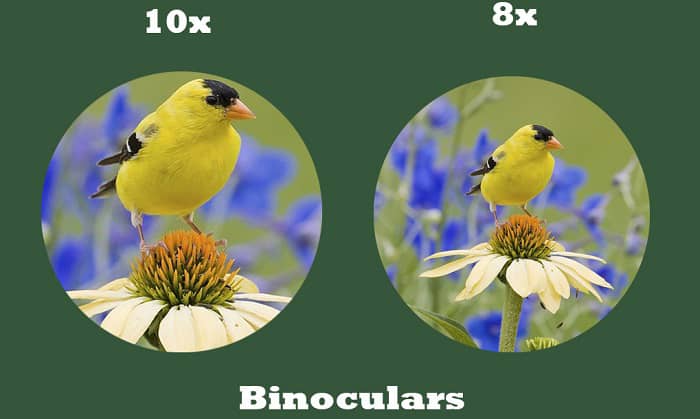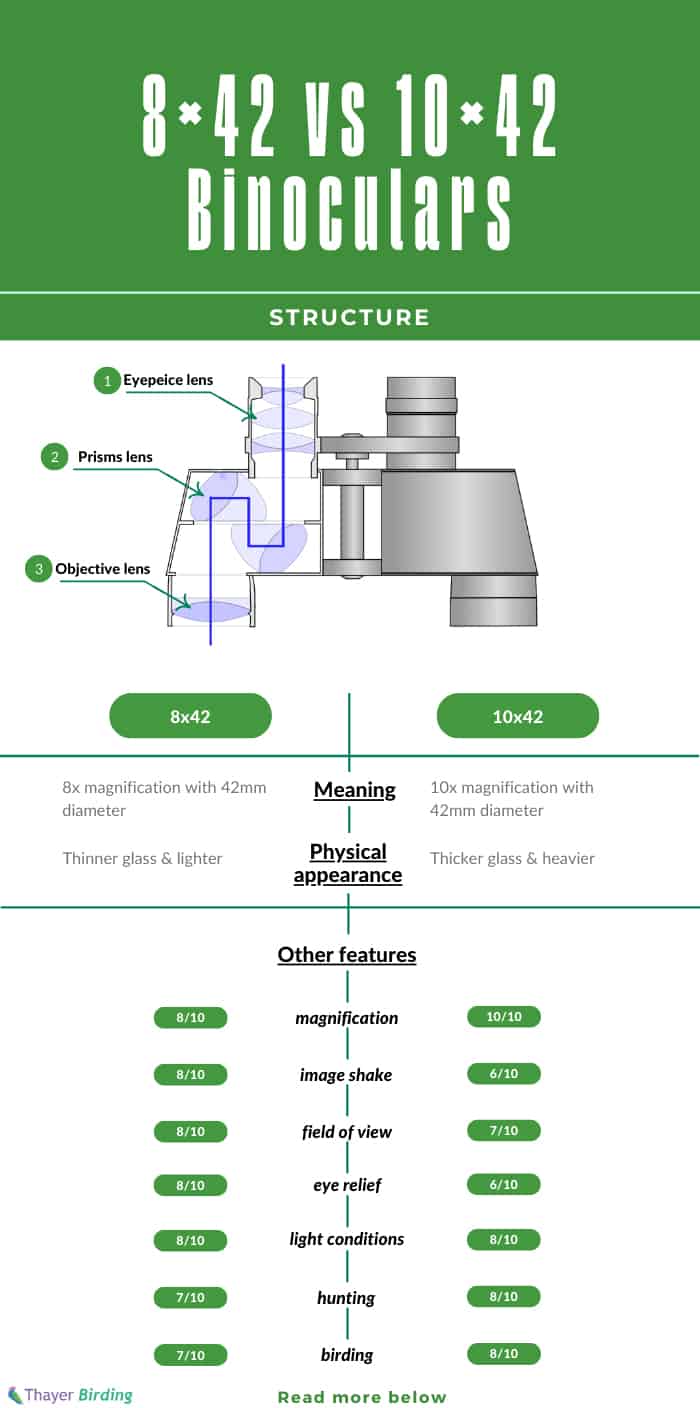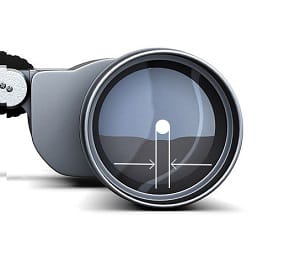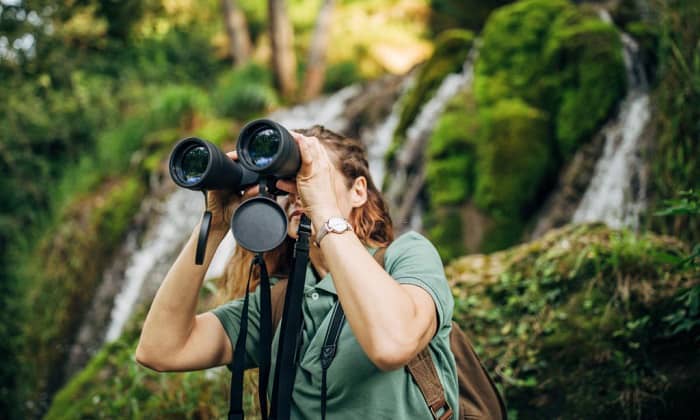Binoculars are known for their spectacular uses in exciting adventures and even daily life. When researching or shopping for a quality pair of binoculars, you’re likely to notice that these two sizes, 8×42 vs 10×42 binoculars are mostly used.
Even though they may seem closely related, one can be preferable to the other in certain circumstances based on the difference that set them apart.
So, which size are you gonna buy? Probably the one that meets your need and purpose, right? To help you decide, I’m going to cover their performance, physical differences and their pros and cons below.
Table of Contents
Structure
Firstly, it is essential that you understand what a binocular looks like and what each part is called.
A modern binocular basically consists of two barrel tubes with eyepiece lenses, a pair of prisms inside and an objective lens.
The objective lens is where the light enters and it increases and magnifies images. In contrast, the prisms reflect and lengthen the light.
8×42 and 10×42 binoculars: What does that mean?
Next, I will explain what the numbers on binoculars really mean, which is very important to know before you dive in deeper.
When you see “8×42” on a binocular, the first number followed by the “x” represents the magnification, which makes everything you look at through the binocular seem eight times larger or closer.
The number that comes directly after the “x” is the size of the lenses. For instance, a 10×42 binocular has 42mm diameter in objective lenses.
The lense size plays a vital role in determining how big and heavy the binocular will be. The larger the lenses, the bigger and heavier the binocular.
In fact, the larger the lenses are, the more they can capture more light because of the increased surface area. So, the brightness and the low light performance depend on how big the lenses are.
Fortunately, the magnification is always included in its name, which is really easy for us at the first step to tell them apart.
Physical appearance
According to the name, the gap in the overall size between an 8×42 versus 10×42 binocular is tremendously minimal because their lenses are obviously both measured 42mm. However, since a 10×42 needs a little thicker glass to create stronger power, it is often heavier than an 8×42 binocular.
10x or 8x magnification
Magnification is a measure that indicates how many times closer or larger an object appears when you look at it through a particular lens. For example, a 10×42 binocular has a 10x magnification, meaning the objects you’re seeing through the lens appear ten times closer than seeing with naked eyes. An 8×42 binocular is also similar to the 10×42 in operation.
The closer you can view the objects, the clearer you can see them. Therefore, higher magnification offers a higher chance of observing greater detail in faraway objects. So you will be able to see more detail at further distances when using a 10×42 binocular compared to an 8×42 binocular, which is equal in quality.
However, although higher magnifications may potentially provide you a further viewing, there are also a few drawbacks to this: image shake, decrease in field of view, and eye relief.
1. Image shake
You should memorize that every single tiny movement of your hands will impact the magnification. Therefore, 10x binoculars will have more image instability than 8x binoculars. The closer you’re viewing, the more your hands affect the image, making it harder to keep still for observing.
Despite the detailed image a 10x has to offer, it won’t be a good idea to go for a 10x binocular if your hands are already shaky. In contrast, if you are extremely attentive and luckily have steady hands, getting a 10x or even above that is absolutely fine.
It is quite difficult to observe the object’s detail and stay steady at the same time. Even if you get a higher magnification binocular, you also get some image shake, which means your utility is not maximized and you won’t appreciate it.
2. Field of view expansion
The field of view is the extent of what you see through the lens at a particular moment.
Another problem you will likely face is that the “zoomed in” image will possibly reduce your field of view, which means you can see less of the big picture.
If the 10x binocular gives you a much more detailed image with a higher power, an 8x will give you a wider field of view to easily spot your target.
When you’re looking through a highly magnified pair of binoculars, you will see less area, which is very difficult to find any small target in a big picture.
However, when viewing at faraway distances, it won’t be such a big deal. But at a closer distance, it is possible that you can not observe the whole area and what is going on all around it, resulting in missing main details.
For example, for hunting and wildlife experience at close to medium distances, an 8x is a very well-considered choice since targets like animals and birds are usually at high speed and a little hard to spot. Similarly, the all blue oceans or all green forests are believed to be challenging settings. So using an 8x with a more expansive field of view will help you locate and follow your target much easier in no time.
On the other hand, if you’re viewing one subject and want to concentrate on it only, a 10×42 will be a great choice, but you may find it difficult to find that subject in the first place.
3. Eye relief
Eye relief is the limited distance from the eyepiece where your eye can see clearly and achieve a whole field of view. Generally, 8x binoculars tend to have longer eye relief than their 10x opponents.
This is such a concerned factor for whoever needs to wear glasses frequently. Reaching at least 16mm of eye relief is absolutely necessary or else everything will be unexpectedly blurred despite any magnification. But, if your eyesight is already excellent, this factor isn’t worth worrying about.
Light conditions
As you can see, both 8×42 vs 10×42 binoculars have objective lenses measured 42mm, and suppose they’re equipped with the same excellent coatings and glass. Their ability to gather light is totally the same.
However, the brightness in their images is considerably different even though they are capable of catching the same volume of light.
1. Exit pupil
It is a small and bright circle in the center of each eyepiece when you look through them at about one foot in front of your face.
The light conditions of the image you see typically depend on the relation between the exit pupil size and your pupil. During low-light moments, people’s pupils have to expand and strengthen to allow more of the rare light in. If your binocular has an exit pupil that is smaller than your dilated pupil, the image you see will turn out to be darker.
How to define the exit pupil:
The exit pupil magnitude equals the diameter of the objective lens divide magnification. For instance, the exit pupil in a set of 8×42 binoculars is: 42mm / 8 = 5.3mm. For 10×42 binoculars, the exit pupil is 42mm / 10 = 4.2mm.
In dark situations, your pupils usually dilate to almost 7mm, which means they are larger than the exit pupil of both sets of binoculars. Because of this, choosing the 8×42 set is a much better choice because they have a larger exit pupil. Thus, the image will appear brighter than the one you get from the 10×42 binocular in the same low light condition.
In contrast, in normal light conditions, our pupils will shrink to at least 4mm. Therefore, both 8×42 and 10×42 binoculars, which have larger exit pupil, will deliver much more light and bright images to your eyes.
2. Glass thickness
The glass thickness is directly proportional to the magnifications. Because higher magnifications need thicker lenses, there will be less light passing through them.
10×42 vs 8×42 binoculars activities
Binoculars are known to be an essential supply on any journey and activity. Following by, here are some of the most common activities to help you decide which set of binoculars fit you best.
1. 10×42 vs 8×42 binoculars for hunting
When it comes to choosing the best hunting binoculars for yourself, the type of hunting you’re going for is a major factor.
If you go bow hunting, you must have known that an arrow doesn’t go as far as a bullet does, which means the extra reach is unnecessary. Assuming you go hunting for speedy wild animals, such as deers or horses, an 8×42 binocular will serve you better. It is because their wider field of view function will help you track and follow these fast-moving animals easier in such an extensive area.
On the other hand, rifle hunting usually takes place at wide and open expanses. In this case, a maximum reach is a key to your successful hunting. Therefore, the extra reach that a 10×42 has to offer will perfectly meet your requirements. Its ability to identify details and gather all of the specific points of your target will surely increase the accuracy of fire.
2. 10×42 vs 8×42 binoculars for birding
Binoculars are almost inseparable tools for anybody interested in birding adventure in the wild. People tend to get the most powerful and zoomed-in binoculars they can find. However, there are a few drawbacks to highly powered viewing: image vibrations and narrow field of view. But it still depends on your demand and what kind of bird watching you’re doing.
For birding that requires very faraway distance viewing, such as hawk or sea watching, a 10x can be the best option for you. If your interest is landbirding, in which you have to observe small birds from dense bushes and trees and quickly follow and stay on them, then you might as well get an 8×42. This is highly powered, has a broad field of view and is easy to hold sturdily. Plus, 8x has been settled on as the standard for general birding.
Prestigious brands
Canon, Hawke, Pentax Vortex, Celestron, Swarovski, Bushnell and more are some of the leading brands which are well-known and widely used on the market.
Conclusions
To conclude, binos are a worthy investment. Higher magnification is not always the case, so don’t forget to identify your demand and consider many features like glass and coating quality, image stability, a field of view and low-light performance. The price and which manufacturer you get your binocular from are indispensable to think of as well.
Here is a brief comparison between 8×42 versus 10×42 binoculars pros and cons to hopefully lend you a hand to decide which model is the best for you.
8×42 binoculars:
- Pros: These binoculars have less image shake, a wider field of view, larger eye relief, especially for those with glasses, better low-light performance thanks to the larger exit pupil. They also help to track your target easier and lastly, they offer a much affordable price.
- Cons: Cannot see far off subjects and images delivered are not very detailed.
10×42 binoculars:
- Pros: With larger magnification, this set helps you see details more clearly and very far off subjects.
- Cons: Images will be less stable, a field of view is narrower and eye relief is shorter. Their smaller exit pupils result in worse low-light conditions and it is more challenging to locate a small target.
Moreover, you also can refer more to other topics about bird:
- What is the name of a bird watcher?
- Ways to do a bird call.
- The type of bird is zazu from the lion king.

George and I became friends after a birdwatching trip with our new group. And we have been enjoying every adventure together. When he told me the idea of establishing a site that shares our experiences and fun, I immediately agreed. After trials and errors, here we have Thayerbirding.



















